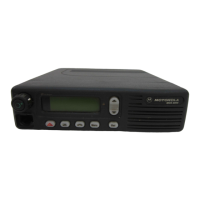302
Fleet A grouping structure used in Type I Trunking. A fleet is a group of radio
users with a common functional responsibility who, under normal
circumstances, coordinate actions among themselves.
Fleet Mapping The process of identifying who needs to talk to whom and how
individual radio users should be grouped. The fleet map also addresses
expansion needs, that is, how many radios can be added to the system
in future.
Frequency The location of an RF channel operating in the radio spectrum
(typically measured in MHz).
Function Keys The ten (or twelve) keys located on the PC keyboard that are labeled
F1 through F10 (or F1 through F12) that perform specific functions
within the RSS.
GET The computer action that transfers data from a radio codeplug or from
a radio archive file to the computer’s RAM for use by an RSS user.
Synonymous with “read”.
Group A collection of radios that communicate with each other.
Handshaking The data interchange that takes place between the radio and the
Central Controller via the control and voice channels. This is to make
sure that each side knows that the other is present on the channel and
is ready to exchange information or allow voice conversation to
proceed.
Hard Disk An alterable permanent magnetic storage medium with a much larger
storage capacity than a diskette, located inside the computer’s system
unit.
Home Channel The channel the user was on prior to pushing the SCAN button.
Home Revert The channel the user will revert to when PTT is pressed while in scan
mode unless the scan talkback feature is enabled. Defines the transmit
channel requirement for a feature. Typically refers to scan mode
operation.
Hz Hertz, or cycles per second.
kHz Kilohertz, thousands of cycles per second.
Logic Board The circuit board within the radio that contains the embedded
microprocessor and other logic-related components.
MDC-1200 A Motorola-proprietary signalling format. It is a binary format using
1200-baud minimum shift keying modulation.
Menu Contains a list of functions that can be selected and performed by
pressing a function key. Also see “Screen”.
Message Upon releasing the PTT, a Portable radio will remain on the voice
channel for a pre-programmed period of time. This allows a response
to be made by other members of the talkgroup without returning to
the control channel for another voice channel assignment. Message
Trunking is commonly referred to as Hangtime on the repeater.
Message Trunking Systems generate less control channel traffic per
conversation than Transmission Trunking Systems.

